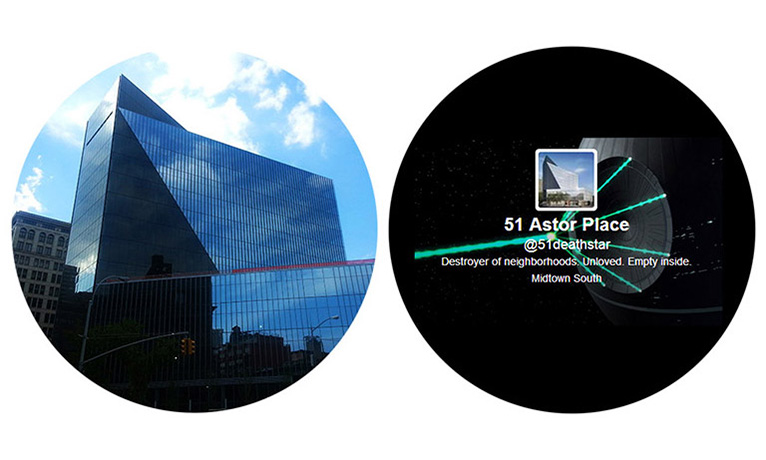A building erects the present in the midst of a nostalgic dream.
51 Astor, a new building on the eastern edge of Astor Place in New York City, looks like something Will Smith would kill in a movie. It is mirrored, angular, black, and malevolently futuristic. Critics ranging from the New York Times to parents of NYU students, as they carry sleek TVs from Volvos to dorm rooms, have lambasted the building. Many activists and developers think the building brings a dash of midtown to an area that ought to be bohemian. At the end of an eloquent critique of 51 Astor, Justin Davidson of New York magazine says it “obliterates the personality of an open-skied funky square.” A fake Twitter account for the building, @51deathstar, which loans it a lonely, hollowly needy persona, recently tweeted in its voice: “Hey East Village! Sorry I had to destroy you. My dad made me do it and he’s kind of a dick.”
To understand why people ascribe this building so much power, a few facts are helpful. In 2011, the building received a $160 million construction loan from Bank of America, rare these days for speculative office spaces in New York City. Its flagship tenant is IBM, which plans to bring Watson, the Kasparov-beating hero to young iPads everywhere. In the lobby is a sculpture by Jeff Koons called Balloon Rabbit. It stands 14 feet tall and weighs 6,600 hundred pounds and is made of genially stacked shiny, semi-tumescent metal parts. The building’s first retail tenant is Ian Schrager, who as the founder of Studio 54, was once the don of decadent, Warholian nightlife in New York. Then he was convicted as a tax evader; now he’s a hotel magnate. One thing is clear: This building isn’t bashful. Its commitment to its attitude is total.
What is that attitude? What is its essence and how does that change in the context of its surroundings? First, its essence might be read from the sum of those facts above: the swinging capitalism of the 1980s. The building recalls Darryl Hannah’s shiny black kitchen in Wall Street. When one considers as a group IBM, Jeff Koons, and speculative black planes of mirrored glass, one thinks of ’80s decadence. But it is now 2014, and one also has to reflect on their strange, ghostly persistence. IBM tanked in the early ’90s but didn’t die; it went on more quietly. Same with Jeff Koons; same with speculative black office buildings made of mirrored glass. All that’s solid melts into air, but occasionally, it hardens years later into glassy value without relinquishing its airy status. It stays this way, guarding its interior, hermetically shiny.
The most salient aspect of 51 Astor is that it is literally a huge, black mirror, shining Astor Place back at itself. Commentary occasioned by the building has made much of the surrounding area’s dimming bohemian aura. When the building was done but empty, I saw people stare at it and say things like, “That thing just kills the vibe.” Meanwhile, what were they actually looking at? At a caustic, unusual building. But they were also seeing a reflection of themselves standing against a backdrop of Chase, Starbucks, K-Mart, Walgreens, a very expensive hippie coffee truck, and a glass tower called Sculpture for Living. These were the buildings and stores that constituted the “funky square,” the area “proudly resistant to change,” in the words of the New York Times. For years, the building’s mirror would have also shown them a utopian, free art school, one that now costs $10,000 a year. Once in a rare while, the building reflects a congregation of homeless youth by the cube, Tony Rosenthal’s iconic sculpture. Then it shows them being shooed away by the police.
“The mirrored façade seems to sharpen reflections to a higher resolution than reality,” writes Justin Davidson of the building. This rings true. For years, it seems, the reality of Astor Place has been a nostalgic dream of itself. Brian Steinweurtzel, managing director of the batteringly named Newmark Grubb Knight Frank, the firm that developed much of Astor between Broadway and Lafayette, even took credit for the survival of a longtime anchor, the cheap barbershop Astor Place Hairstylists, stating that “the neighborhood will always have a casual flavor.” (Hard to say whether, in Steinweurtzel’s mind, this was surmise or calculation; one suspects that one half of “casual flavor” is inapt.)
51 Astor acts as a frank reminder of the area’s more recent roots, the supplier of its aura for the past decade or so: finance capital. It does so with strangeness, elegance and wit. Can this mirror-mirror building help Astor Place see itself for what it is, see the urbane mallhood into which it’s slouching? As recently as last year, when the Cooper Union students began to organize against the end of free tuition, the neighborhood saw a major spike in political action. For years the neighborhood was a nostalgic, lucrative, touristic dream. Maybe 51 Astor will reflect a more wakeful time.
